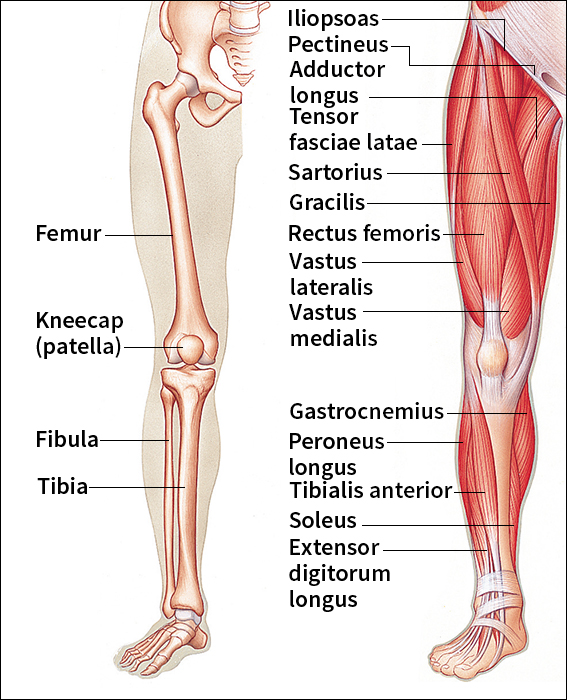Leg is the limb that supports the body of a human being or animal. Properly, it is only that section of the lower limb between the ankle and the knee. The part of the limb between the knee and hip is called the thigh. In human beings, the thigh contains the femur, the longest, strongest bone of the body. The femur meets the hipbone at the hip joint. The hip joint is a ball-and-socket joint that allows a person to move the limb freely, but also provides the stability needed to bear the weight of the body. See Hip .

The thigh.
Muscles attached to the bones by tendons (strong cords of tissue) make it possible for people to move their limbs. The front of the thigh consists of a four-parted muscle, the quadriceps femoris. This muscle allows a person to straighten the limb at the knee, and to bend the thigh at the hips. Three long muscles, called the hamstring muscles, allow a person to bend the knee and straighten the thigh. The length of the hamstrings varies considerably among people. In some people, the hamstrings will not stretch enough to allow the person to touch the toes with the fingers. In others, the hamstrings are long, allowing the person to touch the floor with the palms or to do a high kick. The tendons of these muscles connect with the leg bones and can easily be felt on either side of the leg behind the knee. The quadriceps femoris and hamstring muscles are chiefly used for walking, running, kicking, and climbing.
Loading the player...Muscle contractions
The leg,
or lower part of the limb, contains two bones. These are the tibia (shinbone), which can be felt close to the middle front section of the leg, and the fibula in the muscles of the side of the leg.
Seven muscles make up the calf (fleshy part of the back of the leg). The gastrocnemius is the most prominent. These muscles allow a person to bend the toes and to raise the body on the balls of the feet. The tendo calcaneus, or Achilles tendon, connects the gastrocnemius and two other calf muscles to the heel bone. This tendon forms the prominent ridge on the back of the leg, extending upward from the heel to the lower calf. Four muscles on the front of the leg bend the foot upward and straighten the toes. Two additional muscles near the fibula bend the foot sideways.
The knee joint,
between the femur and tibia, acts like a hinge. It also allows a little movement from side to side. The patella (kneecap) is a triangular bone in front of the knee joint. It acts as a pulley for the tendon of the quadriceps femoris muscle.
Blood and nerve supply.
The femoral artery is the main artery that carries blood to the lower leg. It runs down the front of the thigh, then travels behind the knee, where it becomes the popliteal artery. Finally, it branches to form the arteries of the leg. The largest nerve of the entire body, the sciatic nerve, extends down the back of the thigh to the leg and foot. The sciatic nerve supplies the nerves for the skin of the foot and most of the leg, for all of the foot and leg muscles, and for the muscles on the back of the thigh.
